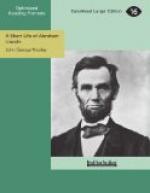When the national Democratic convention met at Charleston, on April 23, 1860, there at once became evident the singular condition that the delegates from the free States were united and enthusiastic in their determination to secure the nomination of Douglas as the Democratic candidate for President, while the delegates from the slave States were equally united and determined upon forcing the acceptance of an extreme pro-slavery platform. All expectations of a compromise, all hope of coming to an understanding by juggling omissions or evasions in their declaration of party principles were quickly dissipated. The platform committee, after three days and nights of fruitless effort, presented two antagonistic reports. The majority report declared that neither Congress nor a territorial legislature could abolish or prohibit slavery in the Territories, and that it was the duty of the Federal government to protect it when necessary. To this doctrine the Northern members could not consent; but they were willing to adopt the ambiguous declaration that property rights in slaves were judicial in their character, and that they would abide the decisions of the Supreme Court on such questions.
The usual expedient of recommitting both reports brought no relief from the deadlock. A second majority and a second minority report exhibited the same irreconcilable divergence in slightly different language, and the words of mutual defiance exchanged in debating the first report rose to a parliamentary storm when the second came under discussion. On the seventh day the convention came to a vote, and, the Northern delegates being in the majority, the minority report was substituted for that of the majority of the committee by one hundred and sixty-five to one hundred and thirty-eight delegates—in other words, the Douglas platform was declared adopted. Upon this the delegates of the cotton States—Alabama, Mississippi, Louisiana, South Carolina, Florida, Texas, and Arkansas—withdrew




